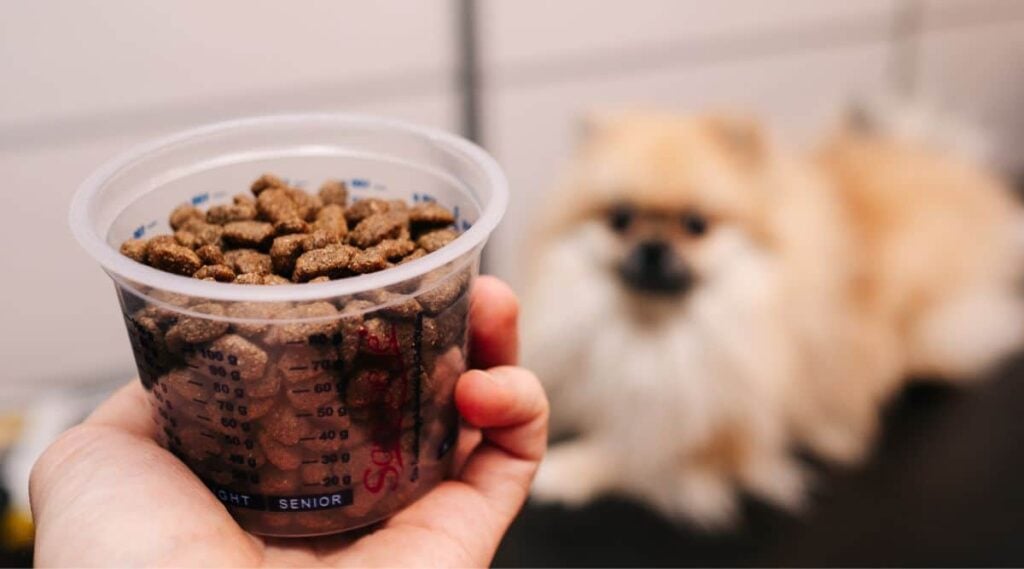Pomeranian Growth Chart: Puppy Milestones & What To Expect
When you purchase through links on our site, we may earn a commission. Here’s how it works.
Have you just become the proud new parent of a Pomeranian and wondered how big they might get? Or maybe you’re looking at the Pomeranian breed and curious whether they are the right size for you and your home. Either way, you’ve come to the right place. How big a Pomeranian gets is one of the most frequently asked questions. After all, their dinky size is one of the reasons we love them.
Table of Contents
Pomeranians are expected to reach between three and seven pounds at maturity, making them one of the most miniature dog breeds in the canine kingdom. They often look heavier than this, but their wild hair is deceiving. Having a reference point regarding size often helps parents with what to expect and soothes any anxieties about whether they are developing as they should be.
This Pomeranian growth chart guide looks at everything you need to know about their growth throughout their first year. As well as what to expect after that and other factors that might influence their size. We also explore all the most frequently asked questions on Pom parent’s lips. Let’s take a closer look.
Pomeranian Breed

Pomeranians are a tiny dog breed, and they are in the American Kennel Club’s (AKC) toy group. The breed standard states they should weigh between three and seven pounds at maturity. They usually measure between six and seven inches tall from paw to shoulder. The outer coat forms a ruff around the neck, shoulders, and chest, and their legs are highly feathered, creating a skirt effect.
Teacup Pomeranians are popular. However, there is a lot of controversy surrounding them, mainly due to their health issues. A teacup Pom is any Pom that weighs less than three pounds. Some breeders advertise their Poms as ‘throwback Pomeranians,’ which are larger pups that usually weigh a minimum of 14 pounds at maturity. So, please bear in mind that this growth chart guide only looks at true Pomeranians, not teacups or throwbacks.
What To Expect & Reminders
We know that Pomeranians are expected to weigh between three and seven pounds when fully grown. Most Pomeranians reach their expected size at around one year old when they are considered adults. Some continue to fill out until they are two or three. But there is more to a dog’s growth than how much they weigh. It’s essential to look at the developmental milestones too. Growth charts are a valuable tool to help parents track their pup’s progress.
It’s important to remember that all dogs are unique, and they all develop at their own rate. Some pups are slow to grow, and others have growth spurts exceeding the charts’ predictions. Some extra small Pom puppies grow into average or large adults, and vice versa. Most deviations are perfectly normal and nothing to worry about.
If you are concerned about your Pom’s growth, do not hesitate to seek advice from your vet. They can study your pup’s development and explore any underlying health concerns. It could be that they are not being fed enough or too much, or maybe they are infected with hookworms or roundworms. Intestinal worms steal calories which can stunt growth, but once your Pom is free of the worms, they usually regain normal development.
Puppy Growth Timeline

This information is a rough guide about what to expect as your Pomeranian goes through the rapid first year of growth. Knowing what to expect can help you to understand their progress and provide the best care. But remember that it is not a definite guideline for all pups. Let’s explore the stages of their growth in the first year.
Birth To 2 Weeks
Newborn Poms weigh very little, often only a few ounces. An average birthweight falls between 2.5 and 5.5 ounces. During this time, they don’t do much other than sleep and nurse from their mother. Puppies are born blind and deaf and must stick close to their mom to develop healthily. Their eyes and ears usually open around two weeks old.
1 Month
At one-month-old, their eyes and ears should be open. They are becoming more aware of their surroundings and starting to explore. Most pups begin recognizing different sounds, and some learn to respond to their name. Their legs are still unstable, but they are beginning to crawl. Although they are still nursing, you can start offering them puppy mush, beginning the weaning process. Most Pom puppies weigh between 8 and 21 ounces.
2 Months
The second month is when most puppies start to stand independently and try to walk. Although they might still be wobbly, they are becoming more coordinated and getting about more. This is also when teething starts, where you might see the beginning of mouthing and chewing. They learn to growl and bark through play with their siblings. Most puppies weigh between 12 and 32 ounces.
3 Months
In the third month, most pups begin to feel confident and active, moving away from their mother. They are becoming sociable and can start to learn commands and house-breaking. Begin leash training with a comfortable harness, removing pressure from your Pom’s neck. And start socializing your pup with other dogs, sights, and experiences to increase their confidence and focus on their manners.
In the first three months, you’ll have seen a considerable difference in their physical development, usually doubling in size. By now, most puppies weigh between 16 and 48 ounces. This is where your puppy enters the world of pounds rather than ounces, equating to between 1 and 3 pounds.
4 Months
At four months old, your Pom puppy is playful and much more confident, and it’s essential to hone in on socialization and training. Be consistent with your training and keep sessions short and fun. Pom puppies are incredibly high in energy and easily stimulated, taking lots of power naps throughout the day to recharge their batteries. Pups should have visited the vets by now for their first set of vaccinations. The average weight is between 1.3 and 3.5 pounds.
5 Months
At five months old, your Pom is very playful, bouncing with energy, and probably a bit clumsy too. By now, you should have a daily routine that your pup is sticking to, with set wake and sleep times and meal times too. The average weight of a five-month-old is between 1.7 and 4.4 pounds.
6 Months
At six months, most puppies begin slowing down in energy and growth rate. But they are still full of beans and need regular exercise and stimulation. This age is ideal to start crate training. Poms are known to be mischievous and suffer from separation anxiety, so investing in a high-quality crate is ideal for both owner and puppy. By now, most puppies weigh between 2 and 5 pounds.
7 Months
The seven-month mark is when your puppy no longer looks like a puppy but nearing the appearance of an adult. But when it comes to their personality, they are more like teenagers, testing your limits and patience. Continue to be consistent with your training and offer rewards for good behavior. At this age, most Poms weigh between 2.2 and 5.4 pounds.
8 Months
Your Pom should be well accustomed to their routine at eight months old. They might still be acting out, but your training should make a massive difference to their manners. Their weight gain is slowing down, and they usually weigh between 2.4 and 5.8 pounds.
9 Months
Your Pom pup is only three-quarters of the way through their first year, but their physical development is almost complete. This is an excellent time to start looking at their transition to an adult diet, usually done at 12 months. At this stage, most puppies weigh between 2.6 and 6.2 pounds.
10 Months
Your Pom has hit double digits, which is when you might start seeing a change in their behavior, becoming less puppy-like. And although you might see a slight drop in their energy, Poms are still active well into their senior years, so don’t expect a considerable change. At ten months, most Poms weigh between 2.8 and 6.5 pounds.
11 Months
There won’t be much change in your Pom from here on in, although some Poms can still experience a growth spurt, so don’t be alarmed if you do. Many Pom parents begin the puppy-to-adult food transitioning phase towards the end of this month. Add a small amount of adult food to their puppy diet, slowly switching it out. At 11 months, most Poms weigh between 2.9 and 6.8 pounds.
12 Months
Congratulations, you have survived the first year with your energetic, sweet, and testing Pom! At one year, your Pom is officially recognized as an adult. Most Poms weigh between 3 and 7 pounds but don’t be alarmed if they are slightly under or over. If you have any concerns, please speak to your vet, who can hopefully reassure you that they are on track.
Pomeranian Weight Chart
| Age | Weight Male & Female (oz & lbs) |
|---|---|
| Birth to 2 weeks | 2.5 - 5.5 oz |
| 1 month | 8 - 21 oz |
| 2 months | 12 - 32 oz |
| 3 months | 1 - 3 lbs |
| 4 months | 1.3 - 3.5 lbs |
| 5 months | 1.7 - 4.4 lbs |
| 6 months | 2 - 5 lbs |
| 7 months | 2.2 - 5.4 lbs |
| 8 months | 2.4 - 5.8 lbs |
| 9 months | 2.6 - 6.2 lbs |
| 10 months | 2.8 - 6.5 lbs |
| 11 months | 2.9 - 6.8 lbs |
| 1 year (12 months) | 3 - 7 lbs |
What Happens Next?
Welcome to adulthood. Your Pom might fill out a little bit with fat or muscle, but they shouldn’t change much more. Pomeranians are very food motivated, so be sure to feed them in moderation and take it easy on the treats. Continue with their regular exercise and mental stimulation throughout the day to keep them happy and healthy. If you notice significant weight loss or gain, please see your vet to rule out any health problems.
Full Grown Pomeranian
Pomeranians are expected to live between 12 and 16 years, a longer-than-average lifespan for a dog. Pomeranians are known for their puppy-like curiosity, cheekiness, and zest for life, so don’t expect this to disappear. But you should notice a little more calmness in your adult Pom compared to them as a pup.
Factors To Consider

Some of them you can’t control, like genetics and health, as this is down to chance and what they inherit from their parents. But there are some factors that you can influence, like nutrition and lifestyle, which can positively impact your pooch. Let’s look at the factors that can affect your Pom’s growth.
Genetics
Genetics is one of the most influential factors in their growth and size. The biggest and easiest indicator is to look at their parent’s size. If they have large Pom parents, they are more likely to be on the larger side, and vice versa. However, this is not always an accurate indicator and should not be relied on. A mixed-breed Pomeranian is likely to be bigger than a purebred Pomeranian.
Nutrition
Nutrition is one of the key influencers on a dog’s development and health, and it determines how big and healthy they become. A dog who eats more grows more, but remember that this is not always healthy. If you feed your Pom too much, they become overweight and unhealthy. But if you provide them with too little, their bodies do not have enough energy to develop as they should.
Feeding your pup a high-quality diet is as important as how much you feed them. Look for a well-known brand that meets the standards of the Association of American Feed Control Officials (AAFCO). High-quality meat should be the first ingredient and contain healthy fats, such as eggs, fish, and flaxseeds, which are crucial for puppy development.
Growth Spurts & Plateaus
Growth spurts and plateaus are something you cannot control, and they happen to most dogs. This is partly because of the substantial energy they use to develop. They can be worrisome for owners, but it is often nothing to worry about. Whatever your concerns, speaking to your vet for a health and development check is always a good idea.
Spay & Neuter
Although spaying and neutering do not impact a dog’s growth, they can impact their development and lifelong health. It’s important to discuss the spay or neuter process with your vet when your Pom is young because doing it at the right time is crucial. Doing it too early or late can cause health issues, such as incontinence or an increased likelihood of developing hip dysplasia or certain cancers.
Physical Health & Activity
Physical health is crucial to your dog’s overall health. They should develop as expected if they eat well, receive proper medical care, and have a safe and happy home. But if they lack high-quality nutrition or have an undiagnosed medical concern, they probably won’t develop as they should.
Your Pom needs to lead an active lifestyle to ensure they are healthy, but providing them with the right amount is crucial to their physical health. Too little, and they might become overweight, and too much, they might overexert or injure themselves. It’s important not to overexercise your Pom as a puppy because their bodies are developing and need to avoid high-impact activity.
Care
The care and love that your Pom receives also impact their growth and development. Dogs need a safe and comfortable environment to grow in and plenty of interaction with their favorite humans. Dogs with little interaction, stimulation, poor training, and lack of exercise develop slower and unhealthy. They are also more likely to become withdrawn and behaviorally problematic.
Frequently Asked Questions
When Do Pomeranians Stop Growing?
A Pomeranian is usually fully grown by 12 months old. Some might fill out a little in terms of fat or muscle, but their body is usually fully developed. All Poms are different, so some might continue to grow a little more.
How Long Is A Full-Grown Pomeranian?
When fully grown, a Pom usually measures 9 to 11 inches long. They typically stand at 6 to 7 inches from paw to shoulders. Remember that teacups or throwback Poms are likely to measure differently than standard toy Poms.
Are Pomeranians High-Maintenance Dogs?
Pomeranians are described as Velcro dogs, and they need to be with their humans for most of the day to remain happy. Other than this, they are typically average when it comes to maintenance. They need daily exercise and weekly brushing, with no unique requirements.
Final Thoughts
The Pomeranian is an adorable small ball of fluffy fun. Poms are popular family pets because of their love, energy, and sweet but cheeky nature. They are toy dog breeds that don’t take up too much room in your home. But despite their small size, they grow incredibly quickly in their first year. Poms only weigh a few ounces at birth, reaching up to seven pounds when fully mature.
Please do everything you can to provide them with a healthy start to life, such as feeding them high-quality nutrition and providing an active lifestyle. If you do this, they should develop healthily according to the growth charts. Remember that all dogs are different, so use the charts as a guide throughout the first year. If you have any concerns, please speak to your vet for advice.



